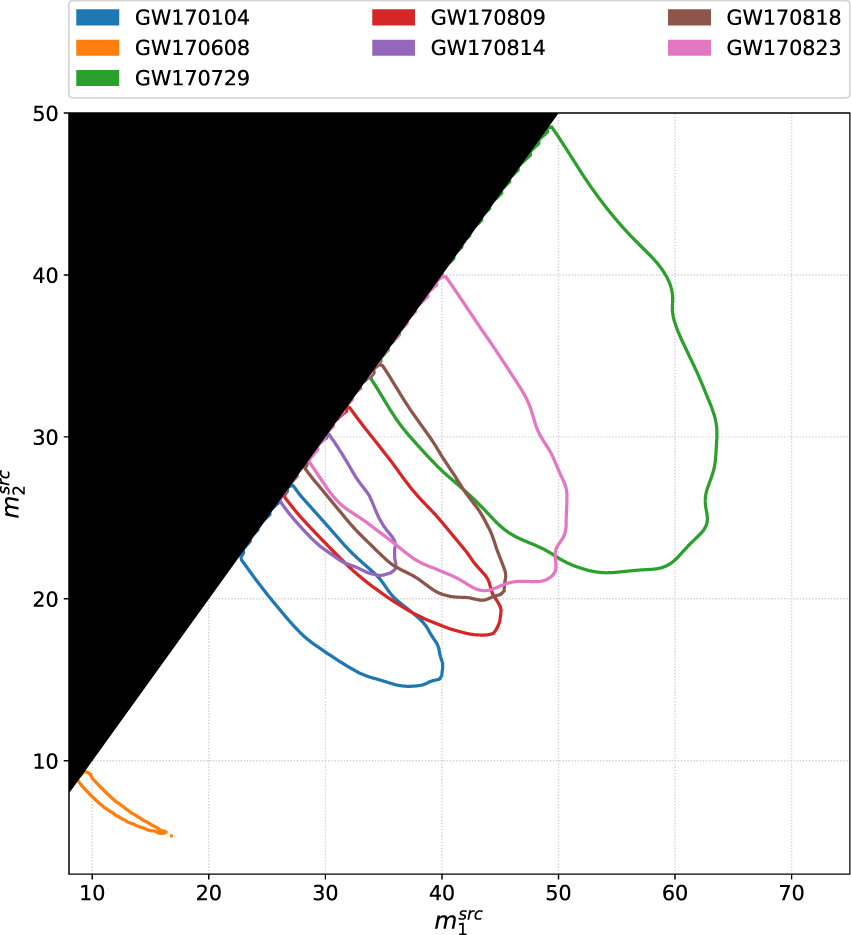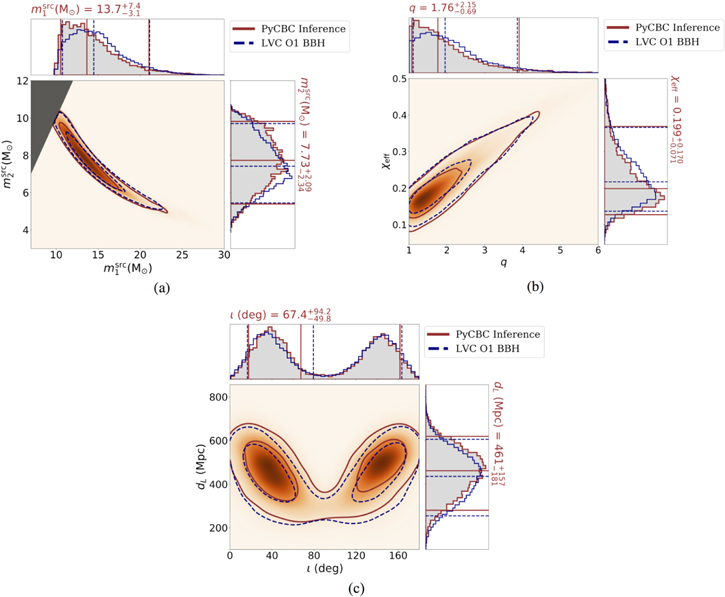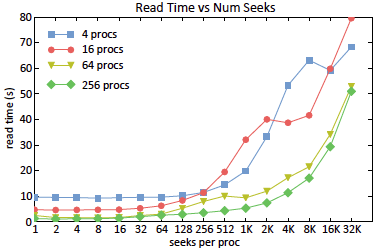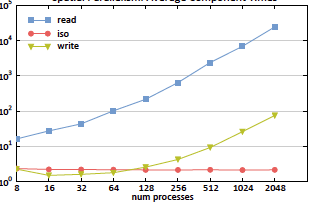2019

De, Soumi; Biwer, Christopher M.; Capano, Collin D.; Nitz, Alexander H.; Brown, Duncan A.
Posterior samples of the parameters of binary black holes from Advanced LIGO, Virgo’s second observing run Journal Article
In: Scientific Data, vol. 6, pp. 81, 2019.
Links | BibTeX | Tags: Data Analysis, Gravitation
@article{De2019,
title = {Posterior samples of the parameters of binary black holes from Advanced LIGO, Virgo’s second observing run},
author = {Soumi De and Christopher M. Biwer and Collin D. Capano and Alexander H. Nitz and Duncan A. Brown },
url = {https://www.nature.com/articles/s41597-019-0086-6},
year = {2019},
date = {2019-06-03},
journal = {Scientific Data},
volume = {6},
pages = {81},
keywords = {Data Analysis, Gravitation},
pubstate = {published},
tppubtype = {article}
}

Biwer, Christoper M.; Capano, Collin; De, Soumi; Cabero, Miriam; Brown, Duncan; Nitz, Alexander; Raymond, Vivien
PyCBC Inference: A Python-based Parameter Estimation Toolkit for Compact Binary Coalescence Signals Journal Article
In: Publications of the Astronomical Society of the Pacific, vol. 131, no. 996, pp. 024503, 2019.
Abstract | Links | BibTeX | Tags: Data Analysis, gravitational waves - methods, statistical
@article{1538-3873-131-996-024503,
title = {PyCBC Inference: A Python-based Parameter Estimation Toolkit for Compact Binary Coalescence Signals},
author = {Christoper M. Biwer and Collin Capano and Soumi De and Miriam Cabero and Duncan Brown and Alexander Nitz and Vivien Raymond},
url = {http://stacks.iop.org/1538-3873/131/i=996/a=024503},
year = {2019},
date = {2019-01-01},
journal = {Publications of the Astronomical Society of the Pacific},
volume = {131},
number = {996},
pages = {024503},
abstract = {We introduce new modules in the open-source PyCBC gravitational-wave astronomy toolkit that implement Bayesian inference for compact-object binary mergers. We review the Bayesian inference methods implemented and describe the structure of the modules. We demonstrate that the PyCBC Inference modules produce unbiased estimates of the parameters of a simulated population of binary black hole mergers. We show that the parameters’ posterior distributions obtained using our new code agree well with the published estimates for binary black holes in the first Advanced LIGO–Virgo observing run.},
keywords = {Data Analysis, gravitational waves - methods, statistical},
pubstate = {published},
tppubtype = {article}
}
2013

Nouanesengsy, Boonthanome; Patchett, John; Ahrens, James; Bauer, Andrew; Chaudhary, Aashish; Geveci, Berk; Miller, Ross; Shipman, Galen; Williams, Dean N
Optimizing File Access Patterns through the Spatio-Temporal Pipeline for Parallel Visualization and Analysis Technical Report
2013, (LA-UR-pending).
Abstract | Links | BibTeX | Tags: Data Analysis, I/O, Modeling, Parallel Analysis, Parallel Techniques, Parallel Visualization, Spatio-Temporal Pipeline, visualization
@techreport{Nouanesengsy2013,
title = {Optimizing File Access Patterns through the Spatio-Temporal Pipeline for Parallel Visualization and Analysis},
author = {Boonthanome Nouanesengsy and John Patchett and James Ahrens and Andrew Bauer and Aashish Chaudhary and Berk Geveci and Ross Miller and Galen Shipman and Dean N Williams},
url = {http://datascience.dsscale.org/wp-content/uploads/2016/06/OptimizingFileAccessPatternsThroughTheSpatio-TemporalPipelineForParallelVisualizationAndAnalysis.pdf},
year = {2013},
date = {2013-10-13},
abstract = {As computational resources have become more powerful over time, availability of large-scale data has exploded, with datasets greatly increasing their spatial and temporal resolutions. For many years now, I/O read time has been recognized as the primary bottleneck for parallel visualization and analysis of large-scale data. Read times ultimately depends on how the file is stored and the file access pattern used to read the file. In this paper, we introduce a model which can estimate the read time for a file stored in a parallel filesystem when given the file access pattern. The type of parallel decomposition used directly dictates what the file access pattern will be. The spatio-temporal pipeline is used to give greater flexibility to the file access pattern used. The spatio-temporal pipeline combines both spatial and temporal parallelism to create a parallel decomposition for a task. Within the spatio-temporal pipeline, all available processes are divided into groups called time compartments. Temporal parallelism is utilized as different timesteps are independently processed by separate time compartments, and spatial parallelism is used to divide each timestep over all processes within a time compartment. The ratio between spatial and temporal parallelism is controlled by adjusting the size of a time compartment. Using the model, we were able to configure the spatio-temporal pipeline to create optimized read access patterns, resulting in a speedup factor of approximately 400 over traditional file access patterns.},
note = {LA-UR-pending},
keywords = {Data Analysis, I/O, Modeling, Parallel Analysis, Parallel Techniques, Parallel Visualization, Spatio-Temporal Pipeline, visualization},
pubstate = {published},
tppubtype = {techreport}
}

Nouanesengsy, Boonthanome; Patchett, John; Ahrens, James; Bauer, Andrew; Chaudhary, Aashish; Miller, Ross; Geveci, Berk; Shipman, Galen; Williams, Dean N
A model for optimizing file access patterns using spatio-temporal parallelism Proceedings Article
In: Proceedings of the 8th International Workshop on Ultrascale Visualization, pp. 4, ACM 2013, (LA-UR-pending).
Abstract | Links | BibTeX | Tags: Data Analysis, file access, I/O, Modeling, Modeling techniques, optimizing, parallel programming, Parallel Techniques, patio-temporal parallelism, visualization
@inproceedings{nouanesengsy2013model,
title = {A model for optimizing file access patterns using spatio-temporal parallelism},
author = {Boonthanome Nouanesengsy and John Patchett and James Ahrens and Andrew Bauer and Aashish Chaudhary and Ross Miller and Berk Geveci and Galen Shipman and Dean N Williams},
url = {http://datascience.dsscale.org/wp-content/uploads/2016/06/AModelForOptimizingFileAccessPatternsUsingSpatio-TemporalParallelism.pdf},
year = {2013},
date = {2013-01-01},
booktitle = {Proceedings of the 8th International Workshop on Ultrascale Visualization},
pages = {4},
organization = {ACM},
abstract = {For many years now, I/O read time has been recognized as the primary bottleneck for parallel visualization and analysis of large-scale data. In this paper, we introduce a model that can estimate the read time for a file stored in a parallel filesystem when given the file access pattern. Read times ultimately depend on how the file is stored and the access pattern used to read the file. The file access pattern will be dictated by the type of parallel decomposition used. We employ spatio-temporal parallelism, which combines both spatial and temporal parallelism, to provide greater flexibility to possible file access patterns. Using our model, we were able to configure the spatio-temporal parallelism to design optimized read access patterns that resulted in a speedup factor of approximately 400 over traditional file access patterns.},
note = {LA-UR-pending},
keywords = {Data Analysis, file access, I/O, Modeling, Modeling techniques, optimizing, parallel programming, Parallel Techniques, patio-temporal parallelism, visualization},
pubstate = {published},
tppubtype = {inproceedings}
}
De, Soumi; Biwer, Christopher M.; Capano, Collin D.; Nitz, Alexander H.; Brown, Duncan A.
Posterior samples of the parameters of binary black holes from Advanced LIGO, Virgo’s second observing run Journal Article
In: Scientific Data, vol. 6, pp. 81, 2019.
@article{De2019,
title = {Posterior samples of the parameters of binary black holes from Advanced LIGO, Virgo’s second observing run},
author = {Soumi De and Christopher M. Biwer and Collin D. Capano and Alexander H. Nitz and Duncan A. Brown },
url = {https://www.nature.com/articles/s41597-019-0086-6},
year = {2019},
date = {2019-06-03},
journal = {Scientific Data},
volume = {6},
pages = {81},
keywords = {},
pubstate = {published},
tppubtype = {article}
}
Biwer, Christoper M.; Capano, Collin; De, Soumi; Cabero, Miriam; Brown, Duncan; Nitz, Alexander; Raymond, Vivien
PyCBC Inference: A Python-based Parameter Estimation Toolkit for Compact Binary Coalescence Signals Journal Article
In: Publications of the Astronomical Society of the Pacific, vol. 131, no. 996, pp. 024503, 2019.
@article{1538-3873-131-996-024503,
title = {PyCBC Inference: A Python-based Parameter Estimation Toolkit for Compact Binary Coalescence Signals},
author = {Christoper M. Biwer and Collin Capano and Soumi De and Miriam Cabero and Duncan Brown and Alexander Nitz and Vivien Raymond},
url = {http://stacks.iop.org/1538-3873/131/i=996/a=024503},
year = {2019},
date = {2019-01-01},
journal = {Publications of the Astronomical Society of the Pacific},
volume = {131},
number = {996},
pages = {024503},
abstract = {We introduce new modules in the open-source PyCBC gravitational-wave astronomy toolkit that implement Bayesian inference for compact-object binary mergers. We review the Bayesian inference methods implemented and describe the structure of the modules. We demonstrate that the PyCBC Inference modules produce unbiased estimates of the parameters of a simulated population of binary black hole mergers. We show that the parameters’ posterior distributions obtained using our new code agree well with the published estimates for binary black holes in the first Advanced LIGO–Virgo observing run.},
keywords = {},
pubstate = {published},
tppubtype = {article}
}
Nouanesengsy, Boonthanome; Patchett, John; Ahrens, James; Bauer, Andrew; Chaudhary, Aashish; Geveci, Berk; Miller, Ross; Shipman, Galen; Williams, Dean N
Optimizing File Access Patterns through the Spatio-Temporal Pipeline for Parallel Visualization and Analysis Technical Report
2013, (LA-UR-pending).
@techreport{Nouanesengsy2013,
title = {Optimizing File Access Patterns through the Spatio-Temporal Pipeline for Parallel Visualization and Analysis},
author = {Boonthanome Nouanesengsy and John Patchett and James Ahrens and Andrew Bauer and Aashish Chaudhary and Berk Geveci and Ross Miller and Galen Shipman and Dean N Williams},
url = {http://datascience.dsscale.org/wp-content/uploads/2016/06/OptimizingFileAccessPatternsThroughTheSpatio-TemporalPipelineForParallelVisualizationAndAnalysis.pdf},
year = {2013},
date = {2013-10-13},
abstract = {As computational resources have become more powerful over time, availability of large-scale data has exploded, with datasets greatly increasing their spatial and temporal resolutions. For many years now, I/O read time has been recognized as the primary bottleneck for parallel visualization and analysis of large-scale data. Read times ultimately depends on how the file is stored and the file access pattern used to read the file. In this paper, we introduce a model which can estimate the read time for a file stored in a parallel filesystem when given the file access pattern. The type of parallel decomposition used directly dictates what the file access pattern will be. The spatio-temporal pipeline is used to give greater flexibility to the file access pattern used. The spatio-temporal pipeline combines both spatial and temporal parallelism to create a parallel decomposition for a task. Within the spatio-temporal pipeline, all available processes are divided into groups called time compartments. Temporal parallelism is utilized as different timesteps are independently processed by separate time compartments, and spatial parallelism is used to divide each timestep over all processes within a time compartment. The ratio between spatial and temporal parallelism is controlled by adjusting the size of a time compartment. Using the model, we were able to configure the spatio-temporal pipeline to create optimized read access patterns, resulting in a speedup factor of approximately 400 over traditional file access patterns.},
note = {LA-UR-pending},
keywords = {},
pubstate = {published},
tppubtype = {techreport}
}
Nouanesengsy, Boonthanome; Patchett, John; Ahrens, James; Bauer, Andrew; Chaudhary, Aashish; Miller, Ross; Geveci, Berk; Shipman, Galen; Williams, Dean N
A model for optimizing file access patterns using spatio-temporal parallelism Proceedings Article
In: Proceedings of the 8th International Workshop on Ultrascale Visualization, pp. 4, ACM 2013, (LA-UR-pending).
@inproceedings{nouanesengsy2013model,
title = {A model for optimizing file access patterns using spatio-temporal parallelism},
author = {Boonthanome Nouanesengsy and John Patchett and James Ahrens and Andrew Bauer and Aashish Chaudhary and Ross Miller and Berk Geveci and Galen Shipman and Dean N Williams},
url = {http://datascience.dsscale.org/wp-content/uploads/2016/06/AModelForOptimizingFileAccessPatternsUsingSpatio-TemporalParallelism.pdf},
year = {2013},
date = {2013-01-01},
booktitle = {Proceedings of the 8th International Workshop on Ultrascale Visualization},
pages = {4},
organization = {ACM},
abstract = {For many years now, I/O read time has been recognized as the primary bottleneck for parallel visualization and analysis of large-scale data. In this paper, we introduce a model that can estimate the read time for a file stored in a parallel filesystem when given the file access pattern. Read times ultimately depend on how the file is stored and the access pattern used to read the file. The file access pattern will be dictated by the type of parallel decomposition used. We employ spatio-temporal parallelism, which combines both spatial and temporal parallelism, to provide greater flexibility to possible file access patterns. Using our model, we were able to configure the spatio-temporal parallelism to design optimized read access patterns that resulted in a speedup factor of approximately 400 over traditional file access patterns.},
note = {LA-UR-pending},
keywords = {},
pubstate = {published},
tppubtype = {inproceedings}
}